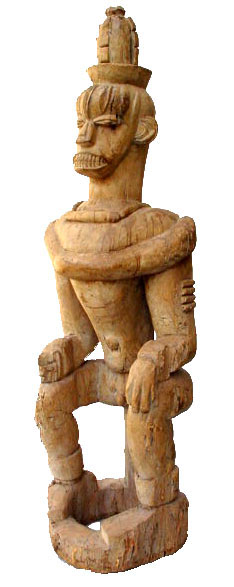Galerie Peter Herrmann - Klassische Kunst aus Afrika |
|
| Male ancestral figure of the Ekpeko society
Urhobo, Nigeria |
This 1.55m figure stood in the holy grove for the worship of the ancestors and the spirits of the wood (edjo re akare) and was looked after by the priest-king Ovie and the Ekpeko society. It has a washed patina and evenly distributed weathering and is well preserved in its general condition. The crown and neck chain indicate a person of renown. The cape around the shoulders refers to sacred duties. The figure seated on a throne gives the impression of enormous power. The exact origin of the statue is no longer known. What is known is that the piece was already part of the collection in the 1950s. Relating to style, the statue has many similarities to the one published in the book "Afrikanische Kunst aus der Sammlung Barbier - Mueller" by Werner Schmalenbach. The one portrayed there was found in 1968 in a shrine for the worship of Owedjebo, the founding hero of Eherhe, an Agbaro village 25 km northwest of Ughelli. It is estimated that the piece was created in 1875. (W. Perkins Foss, 1976) With this statue, the sculptor captured the principle of quiet and dynamics presented together in one object — an aesthetic widespread in Africa. The calm pose seemingly contradicts the vivacity of its physiognomy. Visible teeth imply conspicious aggression, yet longer reflection allows an absolute friendly interpretation. The moment of perception leaves the figure in a continuous field of tension. |
